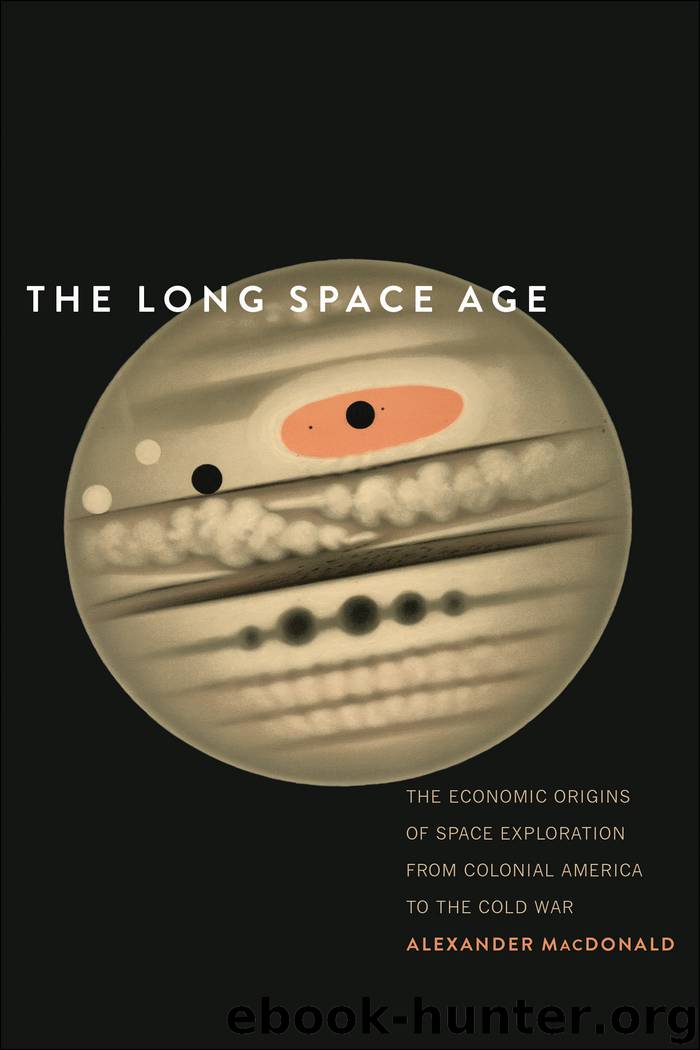The Long Space Age by Alexander MacDonald

Author:Alexander MacDonald [MacDonald, Alexander]
Language: eng
Format: epub
Publisher: Yale University Press
Published: 2017-04-30T23:00:00+00:00
Sources: Goddard, R., The Papers of Robert Goddard, vol. 1 (New York, 1970); see text of chapter 3 for specific source references. PWC-ratio equivalent value and GDP-ratio equivalent value calculations done using measuringworth.com.
The extent of the private philanthropic support that Goddard drew upon is quite impressive. No less than five separate bequests provided him with funding: those of James Smithson, Thomas Hodgkins, Frederick Cottrell, Andrew Carnegie, and Daniel Guggenheim. None of these mostly deceased philanthropists had been personally interested in spaceflight technology. Even Daniel Guggenheim, who provided the funds while still alive, was motivated to do so principally out of the interest of his son Harry and the persuasion of Charles Lindbergh. This underscores the critical importance of well-connected patrons in Goddard’s career. Goddard had a variety of such patrons that provided him with institutional support and connections to funding: Charles Walcott, Charles Abbot, Wallace Atwood, Charles Lindbergh, Harry Guggenheim, and George Lewis. Not only was Goddard’s progress driven forward by his own intrinsic interests, he was also able to connect with patrons who either shared his interests directly or who saw alignment of their own intrinsic interests with what Goddard was seeking to achieve.
As we have already seen in the history of the American Observatory Movement, the private funding attracted by Goddard is not an anomaly in the history of space exploration. On the contrary, Goddard’s program can be seen as part of a continuum of private funding for American space exploration going back for more than a century. Both as a share of total economic resources and in terms of equivalent production worker compensation, Goddard’s career funding falls far short of the level of funding lavished on many of the nineteenth- or early-twentieth-century observatories. Nevertheless, at over $70 million in 2015 GDP-ratio terms, Goddard received over the course of his career a level of funding not dissimilar to what might be required for a nontrivial NASA technology development program of the twenty-first century. Or to put it into a more historical context, the next privately funded liquid-fuel rocketry program to receive similar funding in the United States would not occur until the first private launch-vehicle efforts of the 1980s.
The fact that Goddard’s project funding, while substantial, was far below what could be obtained by American observatories can be attributed in part to the limited signaling ability of Goddard’s early research and development program. With his rockets at a prototype phase and with so many fits and starts to his experimental programs, Goddard was unable to provide the type of signal that could command the private funds he required: given the stage of his research, it was often enough of a signal of far-sighted beneficence for his institutional funders at Clark University and the Smithsonian to fund him at all. When signaling did become a motivating concern, as in Abbot’s impatience for a spectacular and newsworthy flight, patrons could be easily disappointed.
Nevertheless, the notion that a wealthy benefactor would come along to support the ambitious professor’s rocket to the
Download
This site does not store any files on its server. We only index and link to content provided by other sites. Please contact the content providers to delete copyright contents if any and email us, we'll remove relevant links or contents immediately.
| Aerodynamics | Aircraft Design & Construction |
| Astronautics & Space Flight | Avionics |
| Gas Dynamics | Propulsion Technology |
Whiskies Galore by Ian Buxton(41941)
Introduction to Aircraft Design (Cambridge Aerospace Series) by John P. Fielding(33095)
Small Unmanned Fixed-wing Aircraft Design by Andrew J. Keane Andras Sobester James P. Scanlan & András Sóbester & James P. Scanlan(32767)
Craft Beer for the Homebrewer by Michael Agnew(18200)
Turbulence by E. J. Noyes(7983)
The Complete Stick Figure Physics Tutorials by Allen Sarah(7339)
Kaplan MCAT General Chemistry Review by Kaplan(6903)
The Thirst by Nesbo Jo(6882)
Bad Blood by John Carreyrou(6585)
Modelling of Convective Heat and Mass Transfer in Rotating Flows by Igor V. Shevchuk(6408)
Learning SQL by Alan Beaulieu(6239)
Weapons of Math Destruction by Cathy O'Neil(6220)
Man-made Catastrophes and Risk Information Concealment by Dmitry Chernov & Didier Sornette(5958)
Digital Minimalism by Cal Newport;(5707)
Life 3.0: Being Human in the Age of Artificial Intelligence by Tegmark Max(5520)
iGen by Jean M. Twenge(5387)
Secrets of Antigravity Propulsion: Tesla, UFOs, and Classified Aerospace Technology by Ph.D. Paul A. Laviolette(5336)
Design of Trajectory Optimization Approach for Space Maneuver Vehicle Skip Entry Problems by Runqi Chai & Al Savvaris & Antonios Tsourdos & Senchun Chai(5040)
Pale Blue Dot by Carl Sagan(4960)
